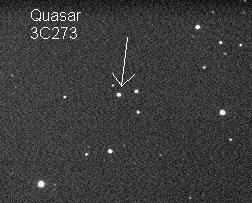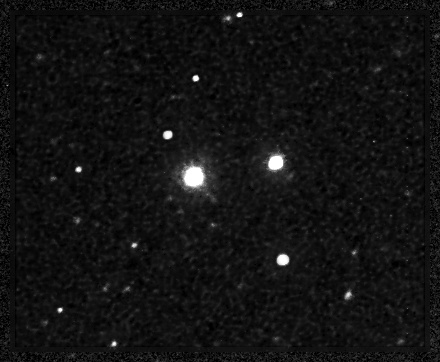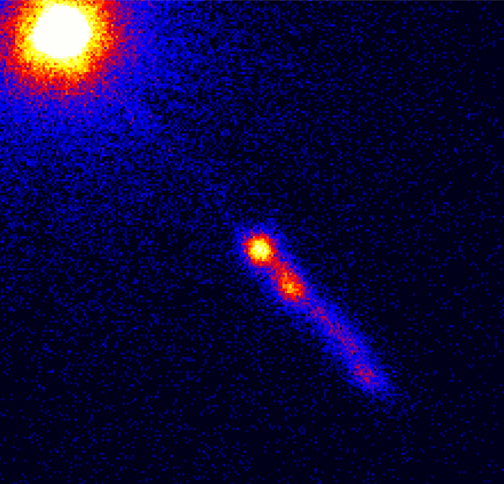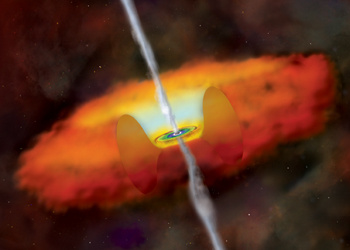- 아마추어 장비로 관측가능한 가장 먼 천체 3c273_퀘이사-
1226+023 3C 273 12:29:06.8 +02:03:07 Vir 12.86v 0.158 br 11.7
20억 광년의 아득한 거리.
그러나 8인치급 아마추어장비로 관측가능한 퀘이사
국내 많은 아마추어 분들도 이 20억년전의 photons을 눈으로 직접
확인해 보시기 바랍니다.
도움이 될까해서 파인더차트도 링크합니다.







=====이미지 모음====

Image of quasar 3C 273 taken by Mike and Debbi Maher on April 16, 1999, within the Kitt Peak Visitor Center's Advanced Observing Program

Quasar 3C 273 as photographed by Alan and Lynn Gingrich on March 24, 2001 within the Kitt Peak Visitor Center's Advanced Observing Program. Note the jet in this image!

chandra-x

퀘이사의 중심부에 있을것으로 예상되는 블랙홀과 분출되는 jet상상도
jet의 길이는 15만광년으로 추정된다고 합니다.
"90미리굴절로 이 퀘이사를 관측한 아마추어의 글 입니다_AP 유저겔"
I had plans to take my 90mm f/5 Stowaway out last night. Sue told me that
Brian Skiff had observed quasar 3C-723 in Virgo with his 70mm Pronto, and
suggested I give it a try with the 90mm Stowaway. Quasar 3C-723 is two
billion light years away, and is one of the most distant objects visible in
a typical amateur's telescope. It is listed as a "challenge object" in the
Observer's Handbook. I had seen it in one of our 8" telescopes, but had
never tried it with anything smaller.
Quasar 3C-273 is not far from Nu Virgo, which serves as a good starting
point for the search. The first goal is a triangle of stars near Nu. Well,
any field of stars is likely to contain many triangles, so I was confused at
first by the view with the 27mm Panoptic. I went inside to do a little
homework - which I should have done earlier - checking the distances on the
finder chart I had and the true field of my eyepiece. Once I had the scale
of things in mind, finding the correct triangle was easy.
The next goal was a line and an arc of faint stars that point toward a
smaller triangle. In the 25mm Pan the line and arc were obvious, but the
smaller triangle was not. I moved to center the region of the sky where
this faint triangle had to be, and put in a 7mm Nagler. The triangle popped
right into view. The quasar should appear right along the hypotenuse, and,
yes, there it was. It was not difficult at all, and I am not surprised it
has been reported in smaller telescopes.
I also wanted to spot a magnitude 13.5 star near the quasar. With the 7mm,
I could not see it, so I put in a 5.2mm Pentax XL, and there it was, most of
the time, anyway. With the 4mm Radian this star was easily and steadily
seen.
It was fun looking two billion years into the past, and a nice change from
my galaxy hopping earlier in the evening. If you haven't visited 3C-273, I
suggest putting it on your list of objects to observe.
1226+023 3C 273 12:29:06.8 +02:03:07 Vir 12.86v 0.158 br 11.7
20억 광년의 아득한 거리.
그러나 8인치급 아마추어장비로 관측가능한 퀘이사
국내 많은 아마추어 분들도 이 20억년전의 photons을 눈으로 직접
확인해 보시기 바랍니다.
도움이 될까해서 파인더차트도 링크합니다.







=====이미지 모음====

Image of quasar 3C 273 taken by Mike and Debbi Maher on April 16, 1999, within the Kitt Peak Visitor Center's Advanced Observing Program

Quasar 3C 273 as photographed by Alan and Lynn Gingrich on March 24, 2001 within the Kitt Peak Visitor Center's Advanced Observing Program. Note the jet in this image!

chandra-x

퀘이사의 중심부에 있을것으로 예상되는 블랙홀과 분출되는 jet상상도
jet의 길이는 15만광년으로 추정된다고 합니다.
"90미리굴절로 이 퀘이사를 관측한 아마추어의 글 입니다_AP 유저겔"
I had plans to take my 90mm f/5 Stowaway out last night. Sue told me that
Brian Skiff had observed quasar 3C-723 in Virgo with his 70mm Pronto, and
suggested I give it a try with the 90mm Stowaway. Quasar 3C-723 is two
billion light years away, and is one of the most distant objects visible in
a typical amateur's telescope. It is listed as a "challenge object" in the
Observer's Handbook. I had seen it in one of our 8" telescopes, but had
never tried it with anything smaller.
Quasar 3C-273 is not far from Nu Virgo, which serves as a good starting
point for the search. The first goal is a triangle of stars near Nu. Well,
any field of stars is likely to contain many triangles, so I was confused at
first by the view with the 27mm Panoptic. I went inside to do a little
homework - which I should have done earlier - checking the distances on the
finder chart I had and the true field of my eyepiece. Once I had the scale
of things in mind, finding the correct triangle was easy.
The next goal was a line and an arc of faint stars that point toward a
smaller triangle. In the 25mm Pan the line and arc were obvious, but the
smaller triangle was not. I moved to center the region of the sky where
this faint triangle had to be, and put in a 7mm Nagler. The triangle popped
right into view. The quasar should appear right along the hypotenuse, and,
yes, there it was. It was not difficult at all, and I am not surprised it
has been reported in smaller telescopes.
I also wanted to spot a magnitude 13.5 star near the quasar. With the 7mm,
I could not see it, so I put in a 5.2mm Pentax XL, and there it was, most of
the time, anyway. With the 4mm Radian this star was easily and steadily
seen.
It was fun looking two billion years into the past, and a nice change from
my galaxy hopping earlier in the evening. If you haven't visited 3C-273, I
suggest putting it on your list of objects to observe.








